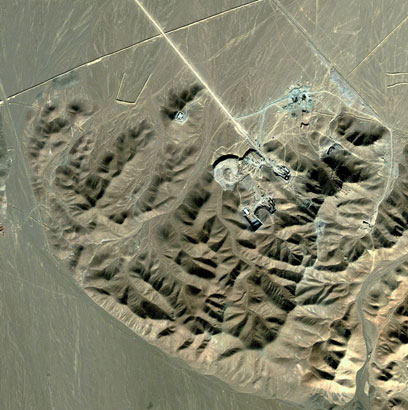Iran brings forward nuclear timetable
Analysis: If Islamic Republic maintains current pace of uranium enrichment at Natanz, Fordo facilities, it can become nuclear power in two years unless stopped
Iran does not have a nuclear bomb, but if it continues to enrich uranium pace at the current pace, it will become a "nuclear threshold" country within a year. According to intelligence officials, there is a possibility that between mid-2014 and the end of that year the Islamic Republic will become a nuclear power with more than one bomb in its arsenal.
To understand how Iran is advancing its nuclear program one must first understand how a nuclear warhead is produced.
The production of a nuclear warhead similar to bomb that was dropped on Hiroshima requires some 25 kilos (55 pounds) of highly-enriched natural uranium containing +90% U-235, the fissile isotope of uranium.
The most difficult stage in this process is enriching uranium to a low concentration level (LEU). One nuclear bomb requires 1,600 kilos (3,530 pounds) of low-enriched uranium that has a 3.5-5% concentration of U-235. The next stage is enriching the uranium to a 20% concentration level. Between 220 and 260 kilos (485-573 pounds) of 20% enriched uranium are required to produce weapons grade uranium, which must contain highly enriched uranium (HEU) with an isotopic concentration greater than 90% U-235. Upon reaching this stage, it takes only a few months to produce enough HEU for a number of nuclear bombs.
- To date, Iran has produced some 6,600 kg (14,550 pounds) of LEU. If the enrichment process continues, it will have enough HEU to build four or five nuclear warheads.
- Iran has already advanced to the next stage and has enriched 1,000 kg (2,200 pounds) of LEU to a fissile concentration of 20%. Currently the Islamic Republic possesses some 160 kg (352 pounds) of 20% enriched uranium (about 100 kg, or 220 pounds less than the amount needed for a nuclear bomb).
- The Iranians have some 10,600 centrifuges in two nuclear plants in Natanz and Fordo. Between 328 and 348 of these centrifuges are already active. The Pakistani-made centrifuges in Natanz, which are less advanced, are mostly used to produce LEU. The centrifuges are concentrated in underground halls that are vulnerable to bombs both Israel and the US possess. But the Natanz plant also contains 164-174 advanced IR-1 Iranian –made centrifuges capable of producing 20% enriched uranium. The centrifuges in Natanz produce four kilos (nine pounds) of uranium enriched to 20% each month. The Fordo centrifuges produce about eight kilos (about 18 pounds) of uranium enriched to 20% every month.
The data indicate that Iran has significantly increased the pace of its uranium enrichment over the past four months. Currently the Islamic Republic produces 230 kg (507 pounds) of LEU each month and 12 kg (about 26 pounds) of uranium enriched to a fissile concentration of 20%.
Most of the efforts to speed up the enrichment process are concentrated in Fordo, where Iran will eventually produce weapons grade uranium if Supreme Leader Ali Khamenei gives the order to do so. In order to shorten the uranium enrichment process, Iran is developing two types of centrifuges, IR-2 and IR-4. Fortunately, Iranian engineers have run into some technical difficulties, and have yet to be able to activate the centrifuges.
The facility in Fordo is situated inside a mountain and is protected by layers of rock. The US Air Force has yet to develop a bomb capable of penetrating the plant. It appears that the Iranians are willing to "sacrifice" the facility in Natanz in the event of an American or Israeli strike.
Should the Iranians continue to enrich uranium at the current pace, they will have some 260 kg (about 570 pounds) of uranium refined to a fissile concentration of 20% in January or February of 2013. With this amount, it would take Iran only about two months to produce weapons grade uranium for a nuclear warhead or bomb – a "nuclear threshold" situation. Western intelligence officials have not identified any "technological bottleneck" that can prevent Iran from enriching uranium to a fissile concentration of +90%, meaning that it could theoretically become a nuclear power by mid-2014 or a few months later.
Such a nuclear "breakthrough" may result in a military confrontation with the US or other countries and put the regime in Tehran at risk. Iran believes that a reliable nuclear arsenal containing a number of nuclear warheads would prevent a military strike and even serve as a bargaining chip to lift the harsh economic sanctions imposed by the West. This is why Khamenei - before deciding on a nuclear "breakthrough" - will likely demand that Iran produce enough 20% enriched uranium for four nuclear warheads.
It is also very reasonable to assume that Tehran is secretly developing nuclear warheads which can be mounted on ballistic missiles already in its possession and on more accurate long-range missiles that are most likely being developed. Iran already possesses missiles with a range of 2,000 kilometers (1,242 miles) that are capable of reaching Eastern Europe.
According to the Pentagon, in 2015 Iran will have missiles that can also pose a direct threat to the US.











